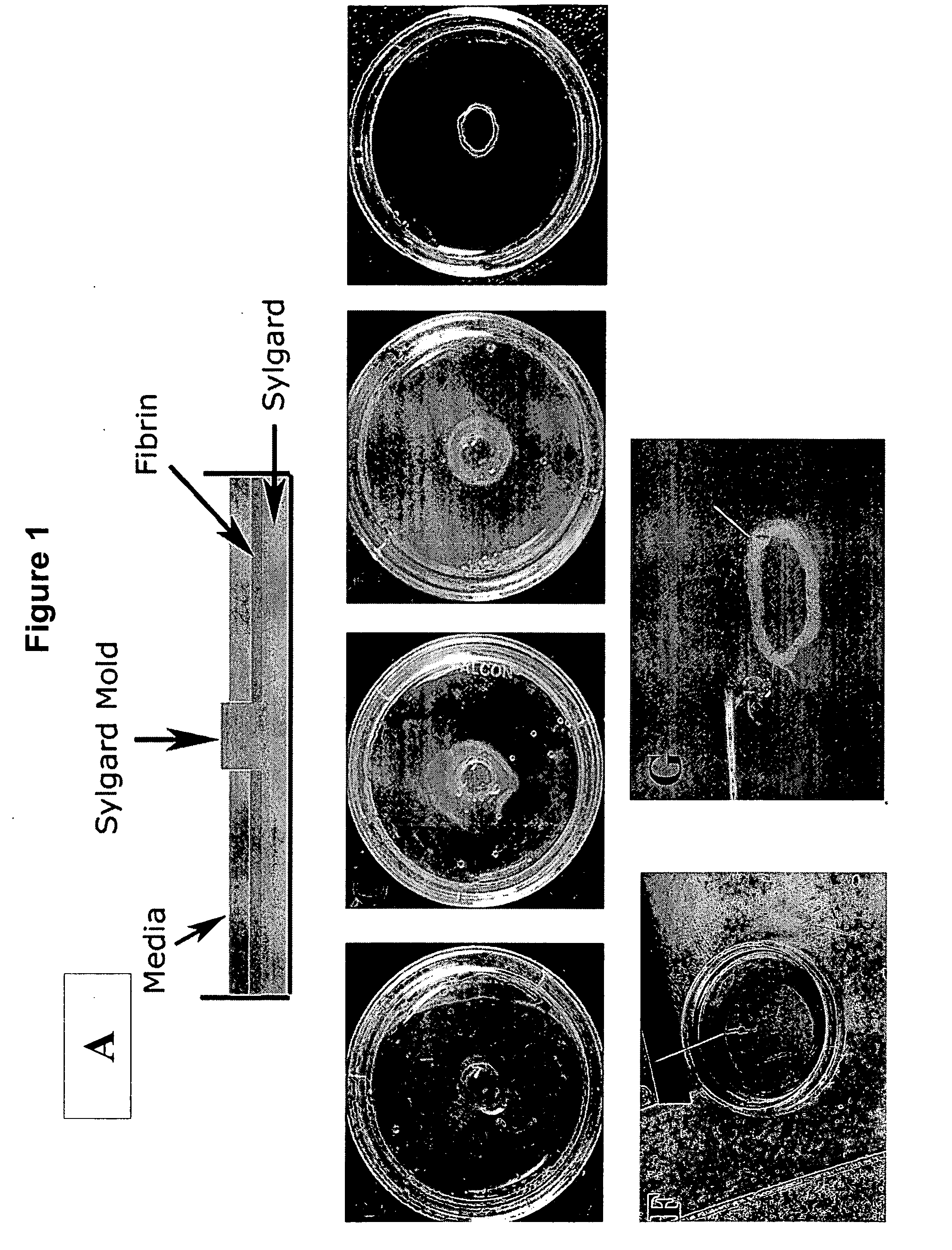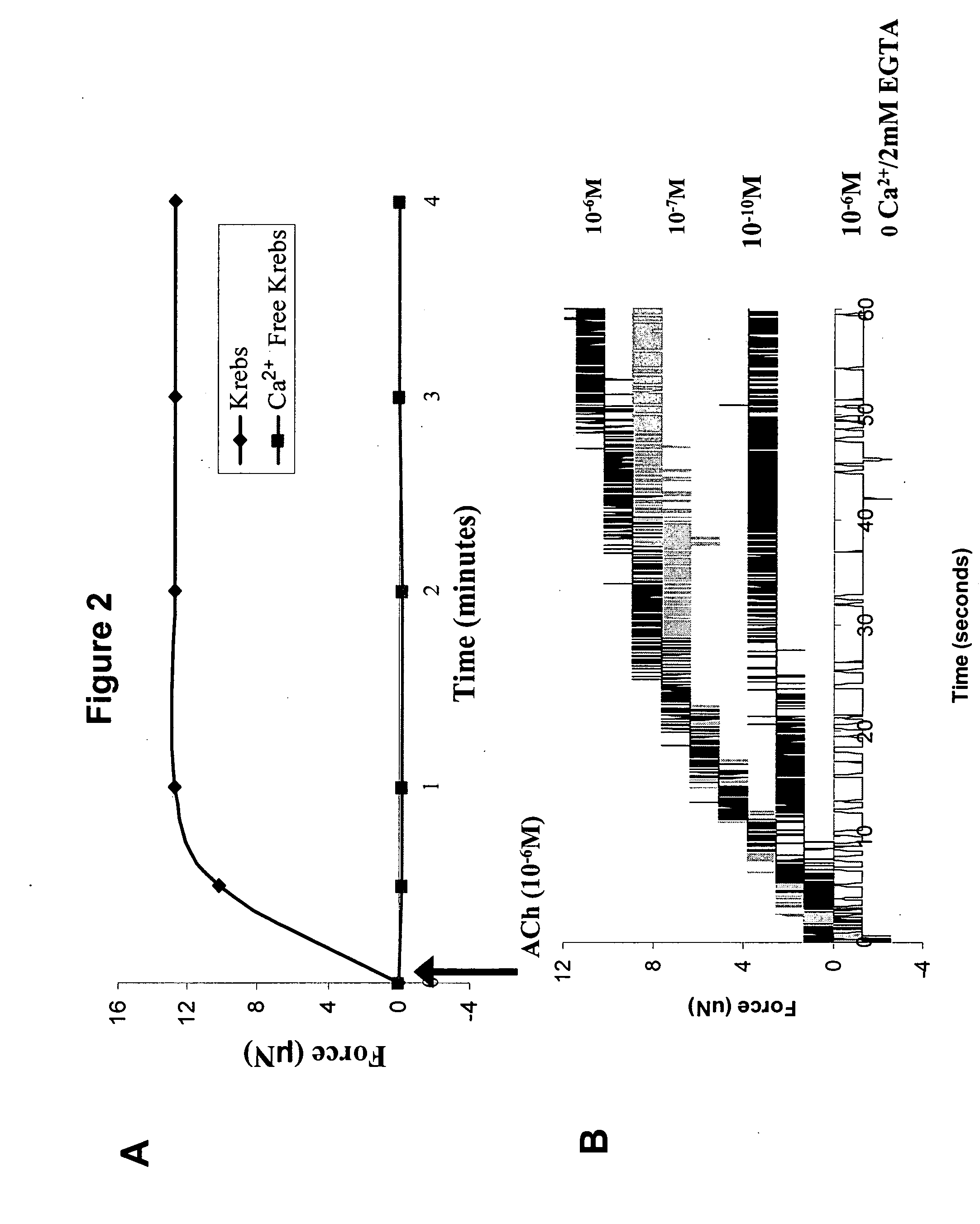Three dimensional bioengineered smooth muscle tissue and sphincters and methods therefor
a bioengineered smooth muscle and cell ring technology, applied in the field of three dimensional bioengineered smooth muscle cell ring and three dimensional bioengineered sphincter, can solve the problems of slow contractile response of skeletal and smooth muscle of sphincter, lack of cell-cell interaction and cell-matrix interaction potential of cell suspension, and lack of two-dimensional cell culture options to study contractile force production, etc., to achieve the effect of restoring the contractile response, re-
- Summary
- Abstract
- Description
- Claims
- Application Information
AI Technical Summary
Benefits of technology
Problems solved by technology
Method used
Image
Examples
example 1
Isolation of Internal Anal Sphincter Cells and Determination of Contractility
[0104] Smooth muscle cells were isolated from the internal anal sphincter (IAS) of New Zealand White rabbits as described previously (Bitar et al., Am J Physiol 260: G537-G542, 1991; Bitar et al., Am J Physiol 242: G400-G407, 1982). Briefly, the IAS, consisting of the most distal 3 mm of the circular muscle layer, ending at the junction of skin and mucosa, was removed by sharp dissection. The sphincter was rapidly cleaned and striped of connective tissue in ice cold carbonated Krebs solution containing 2% penicillin-streptomycin. The tissue was cut into small pieces and transferred to a 100 mm plate containing 15 ml of HEPES buffer (pH 7.4; NaCl (115 mM), KCl (5.7 mM), KH2PO4 (2.0 mM), HEPES (24.6 mM), CaCl2 (1.9 mM), MgCl2 (0.6 mM), glucose (5.6 mM), 0.01% soybean trypsin inhibitor, and 0.184 (wt / vol) DMEM) with 0.1% collagenase type II (Worthington Biochemical Corp., Lakewood, N.J.) for digestion in an i...
example 2
Bioengineering a Three-Dimensional Sphincter Ring
[0107] Culture plates (35 mm) were prepared as described previously (Dennis et al., In Vitro Cellular &Developmental Biology Animal 36: 327-335, 2000). Briefly, 1.5 ml of the polymer SYLGARD™ (polydimethylsiloxane—PDMS) was poured into each plate and allowed to cure for 24 hours. The polymer layer provided an anchor that materials could be easily pinned in place and provided a surface to which, unless coated, the cells could not adhere. A 5 mm diameter cylindrical SYLGARD mold was placed in the center of the dish to provide a luminal space for the engineered sphincter (FIG. 1, Panel A). Adhesion of the mold to the SYLGARD coated culture dish was facilitated by pressing the mold firmly against the bottom of the dish with forceps. The culture dish was sterilized with 70% ethanol for 30 minutes. Ethanol was then aspirated and culture dishes were exposed to UV light for 1 hour. Subsequently, growth media (500 μl) containing 10 U / ml throm...
example 3
Agonist-Induced Contraction and Relaxation of Bioengineered Sphincter Rings
[0112] Excitability and contractility of bioengineered IAS rings was measured using techniques adapted from previous work (Dennis et al., In Vitro Cellular &Developmental Biology Animal 36: 327-335, 2000. Dennis et al., American Journal of Physiology Cell Physiology 280: C288-C295, 2001). The diameter of the sphincter rings was measured and used to calculate cross-sectional area (CSA). The bioengineered sphincters were separated from their molds using forceps (FIG. 1 Panel E) and the minimum ring diameter was measured using a calibrated eyepiece and a 5× or 10× objective lens on an inverted microscope (Zeiss Axiovert 25, Thornwood, N.Y.). The cross section was circular, and therefore the CSA was calculated using the measured diameter.
[0113] To measure the passive baseline force, the differentiation media in the plate containing the bioengineered sphincter was replaced with 37° C. Krebs solution (NaCl (119 m...
PUM
| Property | Measurement | Unit |
|---|---|---|
| diameter | aaaaa | aaaaa |
| volume | aaaaa | aaaaa |
| thick | aaaaa | aaaaa |
Abstract
Description
Claims
Application Information
 Login to View More
Login to View More - R&D
- Intellectual Property
- Life Sciences
- Materials
- Tech Scout
- Unparalleled Data Quality
- Higher Quality Content
- 60% Fewer Hallucinations
Browse by: Latest US Patents, China's latest patents, Technical Efficacy Thesaurus, Application Domain, Technology Topic, Popular Technical Reports.
© 2025 PatSnap. All rights reserved.Legal|Privacy policy|Modern Slavery Act Transparency Statement|Sitemap|About US| Contact US: help@patsnap.com



